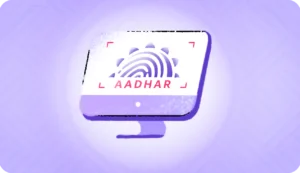Each customer must be assigned a unique online identity so that the transactions that they make may be recorded and monitored. eKYC makes use of Aadhaar, a numeric identifier for every person who is a citizen of India, adding scope for digital identification services and providing a unique means of identification. Aadhaar KYC has ushered in an era of digital enablement all over the country.
Why Aadhaar-based KYC?
eKYC not only is a secure way to do KYC, it also reduces the risk of fraud for the digital lenders. For the purpose of verification of the customer’s identity, the details are fetched online by the app from UIDAI’s servers with proper authentication. At the center of this secure identification process is a 12-digit Aadhaar number, which is meant to replace the PAN card in all transactions except when one is filing taxes and in other scenarios. Paperless Aadhaar KYC is the future of secure ID verification all over India, and perhaps the world, each country with its own unique national ID.
Benefits of Aadhaar KYC
Aadhaar KYC is a gamechanger for the financial services industry. There are many reasons why Aadhaar-based paperless KYC is beneficial. Aadhaar based KYC does not require any manual intervention or the need for any other data or request the use for any other additional information. Being paperless, it is secured with end-to-end encryption, which makes it tamper proof also.
Data covered in an Aadhaar KYC
In a paperless Aadhaar KYC, the data that is covered is the same as in a KYC, the only difference being the process is much faster. The name, address, gender, date of birth, year of birth, photo and the unique QR code on the Aadhaar is shared. The whole process of the loan app sending the data to UIDAI is end-to-end encrypted, which makes the data private and secure. In an Aadhaar eKYC, the user is required to enter the Aadhaar number and then provide a share code along with the OTP that is generated for the specific Aadhaar card number. However, in several digital lending apps, the front and back of the Aadhaar is scanned and provided so that OCR and face recognition can also be used to verify the identity of the user.
How eKYC improves identity verification?
Electronic KYC improves identity verification, ensuring that every person’s onboarding process remains unique and secure. Only an unbiased system can gain access to the user’s details and therefore there is no risk of misidentification. There is no need for human validation, which also speeds up the process of Aadhaar-based KYC. The AI-backed OCR and face recognition further rescue the risk of false-positives or false-negatives being generated by the system.
Steps in eKYC
During every identification process, the digital lender will query the UIDAI website on behalf of the customer to gather the info and verify it against what has been provided by the customer. There is a fully automated KYC mode which the organization can use. On approval from the customer and sending a token to UIDAI, an OTP will be generated and shared with the customer to verify Aadhaar details. The salary and the details of the account where the amount must be disbursed are verified next. The last steps would involve signing a contract and is followed by the disbursal of the loan. The process is very seamless and user-friendly.
Sharing eKYC data offline via Aadhaar
But it is also possible to share eKYC data offline via Aadhaar. In this case, OCR and face recognition technologies will also play a crucial role. A picture of the Aadhaar is captured on the mobile camera and shared by the user. Alternatively, it could be uploaded from the gallery in the smartphone. Once the front and back sides of the Aadhaar, the AI gets to work. Using advanced face recognition techniques, it first analyzes the photo in the Aadhaar and validates it. OCR helps establish that the information contained in the Aadhaar card including address and the QR code are genuine and belong to the person in question.
Conclusion
Aadhaar KYC is a monumental leap towards achieving a digitally transformed set of processes in every organization and at every level in India. The Aadhaar became a unique identification for each citizen and the eKYC associated with Aadhaar today helps FinTech organizations pick the right customers and pitch their loans to them. HyperVerge’s OCR capabilities and face recognition tech has injected a dose of speed and accuracy into the FinTech world. Organizations are jumping on the bandwagon to a better future, and we are delighted.
FAQs
Is Aadhaar KYC accepted by the Ministry of Finance in India?
Yes, Aadhaar KYC is accepted by the Ministry of Finance under the Prevention of Money Laundering Act (PML). The government has also issued a statement regarding the number of such Aadhaar cards that have been assigned all over the country.
How does Aadhaar KYC become more inclusive?
There are two ways the process of KYC using Aadhaar is very inclusive: 1. The KYC using Aadhaar is voluntarily done by each card holder and the entire process is holder-driven. 2. Any agency, regardless of the type of industry, can use the Aadhaar card details of the individual as a means of identification, with their consent.
What are the two formats in which a card holder can share offline Aadhaar KYC data?
The two formats in which the data can be shared are PDF and XML.
How is the Aadhaar XML validated?
Aadhaar is zipped up with a share phrase and then shared for verification. This ensures that it remains secure during the transmission. The Aadhaar XML can be validated by: 1. Parsing the data after unzipping the XML file by entering the share phrase 2. OTP validation by asking customer for a mobile number 3. Face recognition of the photo provided in the Aadhaar





